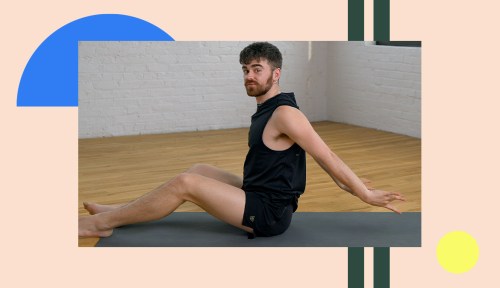Roll Out Your Neck and Shoulder Tension With This One Trick
Roll out the tightest neck and shoulder tension with this one trick from East River Pilates instructor Brian Spencer.

Neck and shoulder tension is honestly the worst. So, if you don’t have a savvy masseuse waiting in the wings, this recent episode of Good Stretch with East River Pilates instructor Brian Spencer can help you attack those knots yourself. All you need is a mat, a tennis ball and a few slow, intentional movements.
Experts in This Article
instructor at East River Pilates in New York City
To start, Spencer has you lay down on a mat and place a small tennis ball (or any ball of that size) underneath your upper trapezius muscle, which extends from the base of the neck to the middle of the back, spanning across your shoulders. With the ball in that area, you make small movements with your head and neck.
Then, you incorporate your arms. First, you raise one arm directly above your head. Then you sit up and cross your arms across your chest and then lay on the tennis ball. All of these moves aim to offer your trapezius muscle some much-needed pressure. Moving your arms changes the position, extension, and engagement of your shoulder muscles, which can, in turn, offer you unique stretches that all work together you relieve built-up neck and shoulder tension.
Spencer stresses that it’s crucial to take stretches like these slower than you usually would. Sometimes, this body area can respond by tightening if you stretch too hard or too fast. You complete the stretch session by switching to your other shoulder and then sitting up for some juicy neck stretches.
Oh hi! You look like someone who loves free workouts, discounts for cutting-edge wellness brands, and exclusive Well+Good content. Sign up for Well+, our online community of wellness insiders, and unlock your rewards instantly.
Sign Up for Our Daily Newsletter
Get all the latest in wellness, trends, food, fitness, beauty, and more delivered right to your inbox.
Got it, you've been added to our email list.










